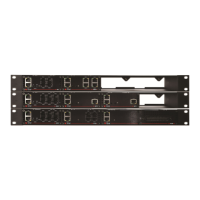QX50/QX200/QX2000; (SW Version 6.0.x) 36
QX50/QX200/QX2000 Manual II: Administrator’s Guide
Paging Group Extension Settings
Paging Group & Access List
The Paging Group service is used to page a group of extensions by forcing extensions to go off-hook and opening one-way communication. The service is
particularly used for announcements addressed to a group of extensions. Service allows to page multiple extensions by dialing the Paging Group
extension.
Please Note: The Paging Group service requires called extensions to use SIP or analog phones which are able to automatically go off-hook. For Paging
service supported on IP phones, refer to the “Epygi IP PBX Features on Epygi Supported IP phones” document on the Epygi’s Web portal.
The Paging Group list is used to define the extensions that will be paged. They will automatically go off-hook when the paging call comes in.
The Access List is used to define PBX, SIP or PSTN users that are explicitly allowed/forbidden to activate the call paging using the corresponding
extension.
When calling to the Paging Group extension, the call will be forwarded to the extensions listed in the Paging Group table. The phones of the called
extensions will automatically go off-hook (the phone speaker automatically becomes activated) and the caller will be able to make his announcement.
Since the paging call opens one-way communication, the called extensions will not be able to give an answer to the caller. To terminate the paging call,
caller should simply hang up.
Attention: Call paging will not work if the called extension is in call.
When caller not listed in the Access List calls the Paging Group extension, password authorization (using the password of the Paging Group extension)
will be required to start the call paging. When a denied user tries to call the Paging Group extension, “Party does not accept your call” message will be
played to the caller. When caller dials the Paging Group extension with empty Paging Group table, “Number dialed temporarily unavailable” message will
be played to the caller.
For Paging Group extensions, Extensions Management - Edit Entry page consists of General Settings, SIP Settings and Advanced SIP Settings pages.
The SIP Settings and Advanced SIP Settings pages are the same as for the regular extensions (see
User Extension Settings), while General Settings page
has a different content:
1.
General Settings
(for paging group extension)
This group requires personal extension information and has the
following components:
Display Name is an optional parameter used to recognize the
caller. Usually the display name appears on the called party’s
phone display whenever a call is performed.
Password requires a password for the new extension.
The extension password may only contain digits. If non-numeric
symbols are entered an “Incorrect Password: no symbol characters
allowed” error will prevent making the extension.
If you are unable to define a strong password, press Choose
Generated Password to use one of system defined strong
passwords. The Password field is checked against its strength and
you may see how strong is your inserted password right below
that field.
Confirm Password requires a password confirmation. If the input
is not corresponding to the one in the
Extension Password
field,
the error will appear: “Incorrect Password confirm”.
Fig.II- 48: Extensions Management - Edit Entry – General Settings for paging extension page
The Edit Paging Group link leads to the page where a list of extensions to be paged can be selected.
Paging Group of Extension
page lists all available regular
and virtual extensions on the QX IP PBX and allows you to manage
the Paging Group.
The Enable functional button is used to include the selected
extension(s) to the Paging Group of the corresponding extension.
Once the call to the paging group comes in, all the extensions in
that group will be paged, i.e. will automatically go off-hook (by
automatic activation of the phone’s speaker).
The Disable functional button is used to exclude the selected
extension(s) from the Paging Group of the corresponding
extension.
Fig.II- 49: Paging Group of Extension page





